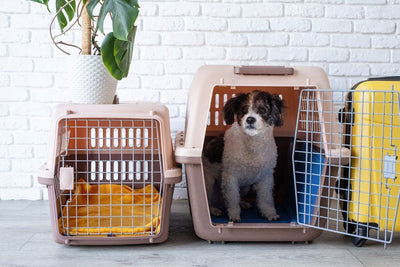 Spend AED 100 more for Free Shipping!
Spend AED 100 more for Free Shipping!
Natural vs Commercial Pet Treats: Which to Choose?

When choosing pet treats in the UAE, your decision boils down to natural or commercial options. Here's a quick breakdown:
- Natural Treats: Made with whole, minimally processed ingredients like real meat, fruits, and vegetables. They avoid artificial additives, preservatives, and fillers. These treats are often better for pets with allergies or sensitivities, promoting healthier digestion, skin, and coats. Examples in the UAE include Nom Nom Pet Treats (AED 20–55), The K9 Kitchen UAE (AED 39–49), and Pawdega (AED 73–92). Downsides? They’re pricier and have a shorter shelf life.
- Commercial Treats: Widely available, affordable (AED 13–30), and convenient. These treats often include artificial flavours, preservatives, and fillers to extend shelf life and enhance taste. While they offer variety and ease of access, they may lack nutritional value and could contribute to long-term health issues.
Key Factors to Consider:
- Ingredients: Natural treats focus on simple, whole foods; commercial ones often include additives.
- Health Impact: Natural treats may reduce allergies and support overall health, while commercial treats are calorie-dense and may include less nutritious fillers.
- Price & Availability: Natural treats are more expensive and found in specialty stores, while commercial treats are cheaper and widely available.
Quick Comparison
| Factor | Natural Treats | Commercial Treats |
| Ingredients | Whole, minimally processed | Includes artificial additives |
| Price Range (AED) | 20–99 | 13–30 |
| Health Benefits | Supports digestion, skin, coat | May lack balanced nutrition |
| Availability | Specialty stores, online | Supermarkets, petrol stations |
| Shelf Life | Shorter | Longer |
Tip: Choose treats based on your pet’s dietary needs, allergies, and activity level. For pets with sensitivities, natural options may be a better fit, while commercial treats work well for quick rewards or training. Always consult your vet for advice tailored to your pet’s health.
Natural Pet Treats: What They Are and Why They Matter
What Are Natural Pet Treats?
Natural pet treats are crafted using whole, minimally processed ingredients. They steer clear of artificial additives, preservatives, and colourings, focusing instead on wholesome, recognisable components like real meat, fruits, and vegetables.
"Natural dog treats come from whole, minimally processed ingredients, often sourced from organic or sustainable farms."
The main distinction lies in what they don’t include. Unlike many commercial treats packed with fillers like corn, soy, and by-products that offer little to no nutritional value, natural treats often feature simple, single-ingredient recipes. Examples include dehydrated chicken breast, sweet potato chips, or freeze-dried liver - ingredients you can easily identify.
Since these treats skip high-heat manufacturing processes and synthetic preservatives, they retain more of their natural nutrients. This not only makes them tastier but also supports your pet’s overall well-being.

Health Benefits of Natural Treats
The perks of natural treats go beyond avoiding artificial ingredients. Their clean composition reduces the likelihood of allergic reactions or digestive troubles, which is especially helpful for pets with sensitivities.
Dr. Rachel Barrack, a certified veterinary acupuncturist based in New York City, highlights the effects of food allergies on pets:
"Many dogs and cats suffer from food allergies... Dog allergies can manifest as red, itchy, paws; itchy, infection-prone ears; and severe skin disease."
Natural treats often exclude common allergens like soy, corn, and wheat, making them a safer choice for pets with specific dietary needs. They can also enhance digestion, promote healthier skin and coats, and even support weight management. Many options are also gluten-free and grain-free, catering to pets with additional dietary restrictions.
Over time, the consistent use of natural treats can contribute to better overall health. In contrast, commercial treats often contain artificial colours, flavours, and preservatives, which may negatively impact your pet’s health in the long term. By sticking to natural options, you’re investing in your pet’s well-being for the future.
Natural Treat Options Available in the UAE
The UAE offers a variety of natural pet treats that cater to local pet owners seeking healthier alternatives. Here are some standout options:
-
Nom Nom Pet Treats: This local brand provides monthly treat boxes made with 100% human-grade ingredients, handmade in the UAE. Their products are free from artificial additives and promote better digestion and healthier skin. Popular items include Organic Bone Broth for AED 32.00 and Healthy Dog Treats priced between AED 20.00 and AED 39.00.

- The K9 Kitchen UAE: Specialising in raw, air-dried treats, this brand offers single-ingredient options like beef, turkey, camel, lamb, rabbit, and chicken. Prices are competitive, with Turkey Jerky and Lamb Trachea at AED 49.00, and Camel Liver and Beef Liver starting from AED 39.00. These are excellent alternatives to heavily processed treats.
- Pawdega: Known for its curated selection of international natural brands, Pawdega offers treats like Green Juju Whole Food Bites (AED 73.00 to AED 79.00), Farm Hounds treats (AED 82.00 to AED 92.00), and Shepherd Boy Farms Freeze-Dried Goat Cheese and Milk (AED 75.00 to AED 89.00). These treats are natural, organic, human-grade, grain-free, and free from synthetic fillers.
When choosing natural treats, opt for brands that are transparent about their ingredients and sourcing practices. Carefully reading labels can help you avoid hidden additives, and introducing new treats gradually will minimise the risk of digestive upsets.
Commercial Pet Treats: Pros and Cons
What Are Commercial Pet Treats?
Commercial pet treats offer an alternative to natural options, bringing their own set of perks and challenges. These treats are mass-produced snacks made using industrial processes, designed for widespread availability. They often include a mix of processed meats, grains, starches, and preservatives, which help extend shelf life and ensure consistent quality across batches.
The industry behind these treats is quite diverse. Traditional baked treats are a staple, while semi-moist options provide a chewy texture that many pets seem to love. Then there are long-lasting options like rawhide chews and dental sticks, perfect for pets that enjoy prolonged chewing. On the more advanced side, you'll find co-extruded treats with multiple layers, double-cooked options for added crunch, and dry expanded food that mimics the look and feel of treats.
Unlike natural treats, which often focus on single ingredients, commercial varieties usually combine multiple components. Processed meats, grains, and starches are blended with preservatives like BHA, BHT, or ethoxyquin to maintain texture, flavour, and freshness. These treats are typically made using high-heat cooking, extrusion, and other industrial techniques, allowing manufacturers to create specific shapes, colours, and flavours, while also controlling nutritional content.

Why Pet Owners Choose Commercial Treats
The commercial pet treat market has seen explosive growth in recent years. Sales of pet treats and chews surged by 20% in 2020, 18% in 2021, and 12% in 2022, reaching a total value of USD 11.3 billion by the end of 2022. So, what’s driving this demand?
- Convenience: These treats are widely available at supermarkets, petrol stations, and online stores, making them easy to purchase without hunting for specialty brands.
- Variety: From training-sized biscuits to large dental chews, commercial treats come in an array of flavours, textures, and formats. Functional treats catering to specific health needs are also gaining traction.
- Longer Shelf Life: Thanks to preservatives and industrial processing, commercial treats stay fresh for months, making them ideal for bulk buying.
- Affordability: Mass production keeps costs down, making these treats a budget-friendly choice for many pet owners.
In addition to these benefits, the industry continues to roll out innovative products. These include treats packed with dietary fibre, portable bar-style snacks for on-the-go pet owners, and creamy options. There’s also been a noticeable expansion into wet, fresh, and frozen pet foods and treats, moving beyond the traditional dry options. However, alongside these advancements, some concerns have emerged about their impact on pet health.
Health Concerns with Commercial Treats
While convenient and diverse, commercial pet treats come with potential health considerations. The heavy processing and use of certain preservatives have raised questions about their effect on nutrient quality and digestibility. Additives like BHA, BHT, and ethoxyquin are approved for use in pet food, but some pet owners prefer options with fewer processed ingredients. Ultimately, it’s essential for pet owners to factor in their pet’s specific dietary needs and consult a veterinarian when selecting treats.
Best Natural Dog Treats That Are ACTUALLY Healthy
sbb-itb-8db4b3d
Natural vs Commercial Treats: Direct Comparison
Choosing between natural and commercial treats for your pet involves weighing their differences in terms of ingredients, nutritional value, cost, and health impact. Both options cater to different needs, but understanding these distinctions can help you make the best choice for your furry friend.
The primary difference lies in the ingredients and processing methods. Natural treats are made with whole, minimally processed ingredients, while commercial treats often include additives to extend shelf life. This divergence directly affects their nutritional value and potential health benefits.
Many commercial treats contain fillers like corn, soy, and by-products that offer little nutritional benefit. To highlight the key differences, here’s a comparison:
Comparison Table
| Factor | Natural Treats | Commercial Treats |
| Ingredients | Whole, minimally processed meats, fruits, and vegetables; often single or limited ingredients [3, 18] | Complex ingredient lists with artificial flavours, colours, preservatives, and fillers |
| Nutritional Value | Rich in essential nutrients, vitamins, minerals, and protein; generally lower in calories | Varies; may be calorie-dense but lack balanced nutrition |
| Health Benefits | Boosts immune system, promotes healthy skin and coat, and suits pets with sensitivities [3, 18] | Convenient and varied; some, like dental chews, can support oral health |
| Health Concerns | Requires proper storage due to shorter shelf life | May include additives linked to obesity and digestive issues |
| Price Range (UAE) | AED 32–99 depending on size and brand [21, 22, 23, 24] | AED 13–30 for standard options |
| Shelf Life | Limited without preservatives | Longer shelf life due to additives |
| Availability | Found at specialty stores and online platforms like The Pets Club | Widely available at supermarkets, petrol stations, and online |
Pricing and Value
Natural treats, such as those from Pet Natural Farm, are priced between AED 32 and AED 46 for 100 g packages, while Nom Nom Pet Treats offers options in the AED 35–55 range. On the other hand, commercial treats like Pedigree Dentastix are more budget-friendly, costing around AED 13.75.
Although natural treats are more expensive upfront, their higher-quality ingredients and potential health benefits could save on veterinary costs in the long run. Conversely, while commercial treats are cheaper, their fillers and additives might contribute to health issues, potentially leading to higher long-term expenses.
Transparency and Accessibility
Natural treats provide greater transparency, allowing pet owners to easily identify the ingredients - an important factor for pets with allergies or sensitivities. In comparison, commercial treats often have lengthy, complex ingredient lists that can be harder to interpret.
For pet owners in the UAE, both options are readily available. Natural treats can be purchased from specialty retailers and online stores, while commercial treats are commonly stocked in supermarkets, petrol stations, and other convenient outlets. Ultimately, the choice comes down to balancing ingredient quality, health benefits, and cost - factors that are at the heart of this comparison.

How to Pick the Right Treats for Your Pet
Choosing the perfect treats for your pet is more than just a simple purchase - it’s about ensuring their health and happiness. With so many options available across the UAE, it’s important to make thoughtful decisions tailored to your pet’s unique needs.
What to Consider Before Buying
When selecting treats, keep your pet’s age, breed size, dietary needs, and activity level in mind. For example, puppies and kittens have different nutritional requirements compared to senior pets, while adult pets benefit from treats that support their active lifestyles. Larger breeds may need appropriately sized treats to reduce choking risks.
Dietary sensitivities are another key factor. If your pet has allergies to common proteins like chicken or beef, or reacts poorly to grains, look for hypoallergenic options. Pets with specific health conditions like diabetes, kidney disease, or obesity require treats that align with their prescribed diets.
Activity level also plays a role. Highly active dogs may thrive on protein-packed treats that support muscle health, while less active pets might need low-calorie options to prevent weight gain. Think about the purpose of the treats too - whether for training, bonding, or dental care.
"Too many treats can interfere with the balance of your pet's core diet - it's recommended that treats make up no more than 10% of a pet's daily calorie intake." - Dr. Lori Teller, Board-Certified Veterinarian and Former President of the American Veterinary Medical Association
Once you’ve considered these factors, the next step is understanding how to evaluate treat labels.

How to Read Treat Labels
Decoding treat labels is crucial to making informed choices. Ingredients are listed by weight, so the first few items make up the majority of the treat. Look for short ingredient lists featuring real meat, fruits, or vegetables.
Avoid treats with fillers like potato, tapioca, corn, soy, and animal by-products. Artificial sweeteners, especially xylitol, are dangerous for pets and should be completely avoided. Similarly, treats with artificial dyes, excessive salt, syrups, or molasses often indicate lower quality.
Check the calorie content on the packaging. Treats that clearly state calories per piece and provide feeding guidelines make it easier to manage your pet’s daily intake.
Quality certifications, such as organic or human-grade labels, can also indicate higher standards. Brands that are transparent about their ingredient sourcing and production methods are often more trustworthy.
By understanding labels, you’re better equipped to find treats that align with your pet’s health and dietary needs.
Finding the Right Balance
Introducing new treats gradually is key to avoiding digestive issues. Start with small amounts and observe your pet for any adverse reactions over a few days. This method helps identify sensitivities and ensures a smoother transition.
Consider adding fresh, pet-safe foods to your treat rotation. Options like carrots, green beans, apples, and bananas are low-calorie, nutritious choices that add variety to your pet’s diet.
For training purposes, use small, bite-sized treats. You can even break larger natural treats into smaller pieces, allowing you to reward your pet multiple times without overfeeding.
If your pet has specific health concerns, consulting your veterinarian is essential. They can recommend treats tailored to your pet’s medical history and nutritional needs, especially for managing conditions like allergies, diabetes, or weight issues.
Treats are more than just snacks - they help build a stronger bond with your pet, enhance training sessions, and provide mental stimulation. Striking the right balance means prioritising treats with quality ingredients while considering your pet’s individual needs and your own convenience.

Conclusion: Choose What Works Best for Your Pet
When it comes to picking between natural and commercial treats for your pet in the UAE, the decision should align with your pet's health, dietary needs, and, of course, your budget. Each option has its own strengths, and the best choice will depend on what matters most to you and your furry friend.
Natural treats focus on whole-food ingredients, offering nutritional benefits that many pet owners value. However, they tend to be pricier and have shorter shelf lives. On the other hand, commercial treats are all about convenience and variety, with the added advantage of being widely available across the UAE.
Interestingly, 80% of surveyed Emiratis rank quality as the top factor when selecting pet food. This highlights a shift among UAE pet owners, who are becoming increasingly mindful of the role treats play in their pets' overall nutrition.
Ultimately, your decision should revolve around your pet's unique needs, as well as the ingredient quality and health benefits we've discussed. A balanced approach often works well - natural treats can serve as everyday rewards, while commercial options are handy for training sessions or when you're out and about.
FAQs
How can I tell if my pet has food allergies and if natural treats are a better option?
If your pet is dealing with symptoms like constant itching, red skin, recurring ear infections, vomiting, or digestive troubles, they might be experiencing food allergies. These signs often point to a negative reaction to specific ingredients in their diet. Reaching out to a veterinarian is essential to get a proper diagnosis, which could include allergy testing.
For pets with food sensitivities, natural treats made with limited, high-quality ingredients can be a great option. These treats usually steer clear of common allergens such as wheat, soy, and artificial additives, making them easier on your pet’s system while promoting their overall health. Always take the time to check ingredient labels and select treats that align with your pet’s unique dietary requirements.
How can I store natural pet treats to keep them fresh for longer?
To ensure natural pet treats stay fresh, store them in airtight containers to block out moisture and prevent contamination. If the treats require refrigeration, keep them in the fridge for 1–2 weeks. For a longer shelf life, freezing them can preserve their quality for several months. Always keep treats in a cool, dry place, away from direct sunlight and heat, to retain their nutritional benefits and flavour.
How can I choose affordable yet high-quality pet treats in the UAE?
Choosing the right pet treats means striking a balance between affordability and nutritional value. While natural treats and premium commercial options often come with better ingredients that support your pet’s health, they can also be on the pricier side. To make smarter decisions, opt for treats with simple, transparent ingredient lists and steer clear of those loaded with artificial additives or fillers.
In the UAE, where the pet care industry is expanding quickly, you can still prioritise quality without overspending. Consider buying in bulk or taking advantage of sales to cut costs. Always choose treats that align with your pet’s specific dietary needs and preferences, as this ensures they contribute to their overall well-being. Spending a little more on high-quality treats now can help you avoid potential health-related expenses down the road, making it a worthwhile investment for your pet's long-term health.

 Facebook
Facebook




